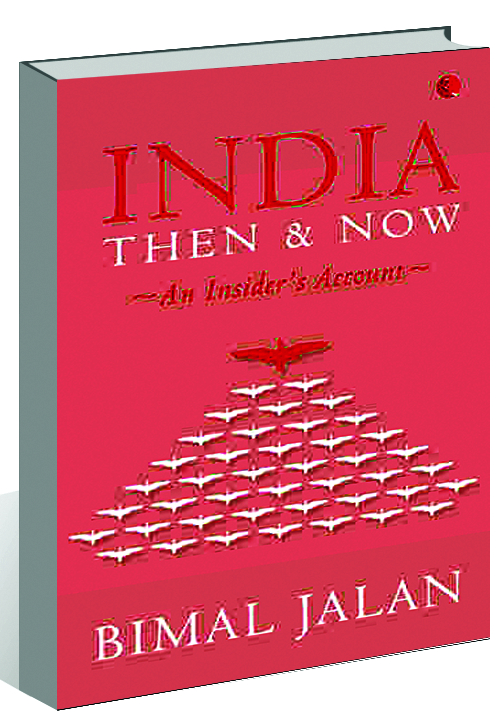India Then and Now: An Insider’s Account by Bimal Jalan. Rupa Publications. Pages 231. Rs495
Book Title: India Then and Now: An Insider’s Account
Author: Bimal Jalan
Rachna Singh
The Indian economy, like the global economy, has shrunk under the impact of the Covid-19 pandemic. The International Monetary Fund slashed India’s growth estimate for Financial Year 2021 to 1.9 per cent from 5.8 per cent, warning that the world was teetering on the brink of the greatest recession since the Great Depression. Naturally, reviving the Indian economy has become a matter of concern. The common man is seeking reassurance that ‘this too shall pass’. Bimal Jalan’s book India Then and Now: An Insider’s Account has hit the stands at a very opportune time. The book, written by a former RBI governor and economic expert, tracks India’s economic trajectory spanning more than seven decades and, in doing so, highlights the fact that India has survived several economic crisis and redefined itself at every juncture. That India pulled through the famine of 1960, the balance of payment crisis of 1990-91, the Gulf crisis of 1991, the East Asia crisis of 1997, to name a few, to a certain extent allays the fear that the pandemic-triggered economic emergency is insurmountable.

The book highlights the fact that India has survived several economic
crisis and redefined itself at every juncture.
The division of the book into three sections that are chronological as well as thematic, makes for a structured analysis which engages the attention of both the expert as well as the general reader. The first section titled ‘The Decade of Industrialisation’ focuses on India’s economic strategy during the 1970s. It was believed that savings rate and growth rate would increase if India invested heavily in capital goods and heavy industry sectors. State control became a necessity as extensive capital deployment could only be sourced by the government. However, industrialisation came with its own problems — increase in social disparity, increased rural poverty and frequent balance of payment problems. Further, the industrial growth logged a low 4 per cent during the 1965-75. 1980 saw a decline in national income and reduced forex reserves. It was time for a paradigm shift.
The second section entitled ‘The Decade of Liberalisation & Globalisation’ discusses the shift in policy framework towards a more outward economic orientation, gradual easing of government controls, industrial deregulation and import liberalisation. Special priority was accorded to agriculture with the objective of attaining self-sufficiency in foodgrains. At the same time there was an emphasis on improvement in key sectors of industrial production. However, faced with ill-effects of the Gulf crisis, collapse of rupee trade and liquidity squeeze, the government, in 1991, needed to redefine its economic policy once again. The East Asian crisis taught India the need for regulation and it was quick to adopt international prudential norms to regulate various sectors and markets. The results were salutary. The third section, ‘India in the Twenty-First Century’, encompasses a broader palette, melding the economic narrative with a discussion on development strategy and policy reforms. The chapter ‘Future Is Ours’ engages the attention of the reader with its honest examination of the existing drawbacks in the fields of governance and politics and makes laudable suggestions to iron out the economic and administrative creases.
Jalan rues the fact that India has failed to alleviate poverty and provide essential social services like education, health care and nutrition to all, despite advancement in other fields. He suggests an increased allocation on social services from the meagre 6 per cent of GDP. For efficient implementation of poverty alleviation programs, Jalan floats the idea of cash vouchers for purchase of goods and services for the poor and channelisation of funds through NGOs. The author also lays out a broad plan for long-term reforms. Creation of jobs in the organised and unorganised sector, addressing export stagnation and flaws in manufacturing policy initiatives should be the primary government agenda. Simplification of administrative and regulatory procedures, transparency in decision making, independence of bureaucracy and reduction in their numbers, ensuring containment of vigilance inquiry on flimsy grounds, strong anti-defection norms, etc. are some of the other sagacious suggestions. The author also emphasises the need to redefine the role of the government in economy. The proposal that implementation of economic policies be left to autonomous and regulatory agencies has merit as also the suggestion that role of government in the field of essential services be expanded but reduced in commercial enterprises.
This is a book that not only systematically tracks India’s economic evolution, but also maps its drawbacks and suggests a way forward in the approach to policy reforms as we head towards 2025 and beyond.














